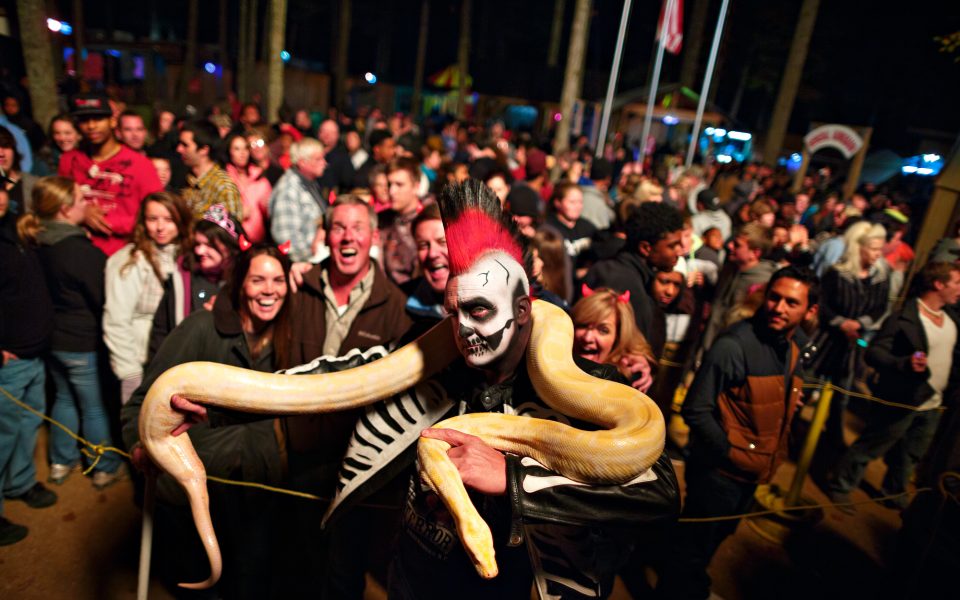by Brian Clarey
They had me sit up front by myself, like a chauffeur, and in the back they squiggled with anticipation and more than a little anxiety.
“Will there be clowns there?” my daughter’s friend asked. “I’m a little bit scared of clowns.”
“There’s no such thing as clowns, honey,” I said.
But I knew damn well that at least a dozen clowns, terrifying one and all, would be stalking the grounds at the Woods of Terror on this night and almost every other through the month of October. I’ve been through the thing at least five times myself over the years, and though each year brings a little something new to proprietor Eddie McLaurin’s outdoor autumn fantasy, there have been a few constants through the years: chainsaws, vampires, zombies and, yes, clowns. It takes an hour to go through the award-winning attraction, with dozens of jump-scares and gallons of blood. By the end of it even the most sanguine among us are genuinely rattled.
I’ve learned, though, with the young ones, not to oversell the fear factor.
When my oldest was 9 years old, he begged to come with me on media night.
“Is it scary?” he wanted to know.
“Totally,” I said. “But if you get too scared, just remember that it’s mostly a bunch of teenagers in really good make-up.”
By the end of the monster parade that kicked off the evening, the kid had pressed himself against me and pulled my shirt over his head.
“They didn’t look like teenagers to me,” he said as we walked out to the car, our cruise through the woods called off for the night.
Three years later, he brought a friend with him, ready to attack the course with gusto. That was the year his younger brother, then 10, insisted on making the trip up Church Street. With an obligation to the other kids and, more importantly, a story to file the next day, I told the youngster that if he came out there with us, there would be no turning back.
He tried anyway, just 15 minutes before we were to go through. Once again it was the monster parade that did him in. We don’t remember if I carried him part of the way through the haunted woods that night, but we both recall how impressed the older teenagers were with him when he ran through the final exit — even for a 10-year-old, he was really small, and they showered him with high-fives.
Still, he has vowed never to return, and has upheld that oath for four years.
And so the Woods of Terror has become something of a rite of passage in my house. When this autumn came around, my 11-year-old daughter thought she might be old enough to take the plunge. And she convinced a friend of the same cohort to accompany her.
We skipped the monster parade on Saturday night, and instead got on the general admission line with the other hooples, where I watched a recognizable look pass over their faces — the look of resignation: This was really happening, no turning back.
Over the years, I have come to love that look.
Woods of Terror gives the illusion of constant danger with exquisitely detailed installations that sprawl over the McLaurin family farm, cartographied with twists and turns designed to disorient, and salted with hiding holes from whence the monsters emerge.
The girls stuck close to me as I navigated the darkness with a glo-stick held before me like Diogenes, but after the first couple scares they became emboldened enough to venture ahead. It was in a room full of nuclear waste barrels, I believe, that I stepped aside to allow a gas-masked ghoul to creep up and scare the bejesus out of them in what was one of the greatest moments in my parenting career.
Me, I’m not scared of monsters with chainsaws or covered in blood — I find enough terror in the real world. But still my heart raced as a wave of zombies emerged from the graveyard.
And everybody is a little scared of clowns.
Join the First Amendment Society, a membership that goes directly to funding TCB‘s newsroom.
We believe that reporting can save the world.
The TCB First Amendment Society recognizes the vital role of a free, unfettered press with a bundling of local experiences designed to build community, and unique engagements with our newsroom that will help you understand, and shape, local journalism’s critical role in uplifting the people in our cities.
All revenue goes directly into the newsroom as reporters’ salaries and freelance commissions.


Leave a Reply